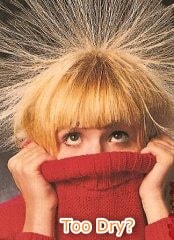FAQ's - Frequently Asked Questions:
Copyright © 1997 Hannabery HVAC. All rights reserved.
Indoor Humidity Explained...

Shown above: Water from excessive condensation
- What is the proper indoor humidity level?
- How humid should my home be?
- What should I set my humidistat to?
- Is too much humidity a bad thing?
- Does it really matter how humid my house is?
- Why do I need a humidifier?
These Are All Great Questions...
So Let's Get Some Answers!
So just what is the best level of humidity for your home during the dry, heating season...

Well, the optimum indoor range is around 35% relative humidity, but 30% to 40% tends to work best for many homes. If you go above this level, condensation on the windows can occur, breeding mold that leads to allergy and respiratory problems.
Dust mites, the leading cause of allergies, thrive in as little as 50% relative humidity. Allergens like molds thrive in relative humidity conditions above 60%, leading to a variety of aliments including asthma, allergies and respiratory infections.
So yes, too much humidity is a bad thing!

Too little humidity on the other hand, can lead to dry nose and throat, dry skin, and static electricity, which can also ruin electronic devices such as computers, VCR's, and DVD players.
Maintaining proper and consistent humidity is also important for the wood inside your home; flooring, doors, and even pianos can shrink, crack, and warp if not properly humidified.
Energy savings is another benefit of keeping the proper humidity level. You will actually feel warmer and more comfortable in humidified air, so you can turn your thermostat down about 2 degrees (saving money), and still feel just as warm. Seriously, it works!
Important Notes...
- Try setting your humidistat to 35% when you first start your humidifier each heating season. After two days, if it still feels dry, turn it up about another 5% and give it two more days.
- And don't forget to make sure your Humidifier is clean and properly setup to run before starting.
Please keep in mind that the information found on our website is provided free of charge and Hannabery HVAC does not assume any liability resulting from the information we provide. We hope this information helps, but please note that these are just rough guidelines, and not all possible situations are covered. Your HVAC system should be inspected and repaired by a trained technician.
How Comfortable Do You Want To Be?
[Must be in our service area]

